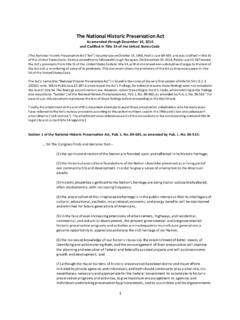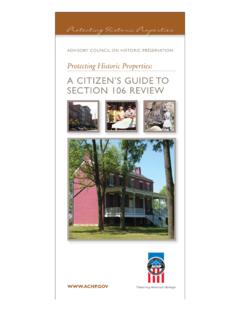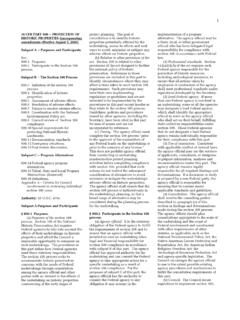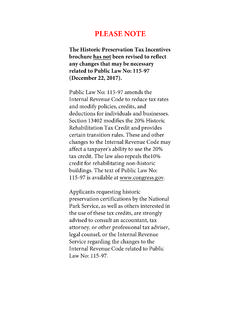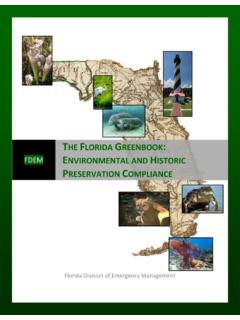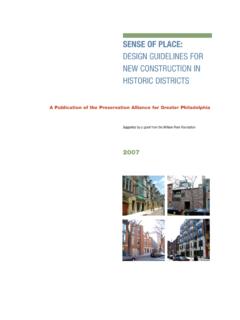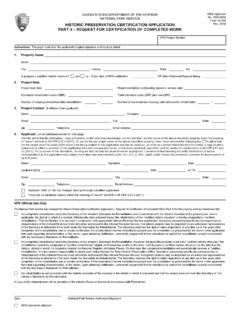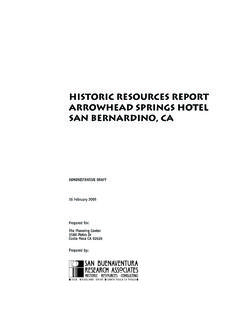Transcription of National Historic Preservation Act of 1966, As …
1 National Historic Preservation Act of 1966, As amended through 2000. [With annotations]. [This Act became law on October 15, 1966 (Public Law 89-665; 16 470 et seq.). Subsequent amendments to the Act include Public Law 91-243, Public Law 93-54, Public Law 94-422, Public Law 94- 458, Public Law 96-199, Public Law 96-244, Public Law 96-515, Public Law 98-483, Public Law 99-514, Public Law 100-127, Public Law 102-575, Public Law 103-437, Public Law 104-333, Public Law 106-113, Public Law 106-176, Public Law 106-208, and Public Law 106-355. This description of the Act, as amended, tracks the language of the United States Code except that (in following common usage) we refer to the Act (meaning the Act, as amended) rather than to the subchapter or the title of the Code. This description also excludes some of the notes found in the Code as well as those sections of the amendments th dealing with completed reports. Until the Code is updated through the end of the 106 Congress, the Code citations for Sections 308 and 309 are speculative.]
2 ]. AN ACT to Establish a Program for the Preservation of Additional Historic Properties throughout the Nation, and for Other Purposes. Section 1. [16 470 Short title of the Act]. (a) This Act may be cited as the " National Historic Preservation Act". [Purpose of the Act]. (b) The Congress finds and declares that . (1) the spirit and direction of the Nation are founded upon and reflected in its Historic heritage;. (2) the historical and cultural foundations of the Nation should be preserved as a living part of our community life and development in order to give a sense of orientation to the American people;. (3) Historic properties significant to the Nation's heritage are being lost or substantially altered, often inadvertently, with increasing frequency;. (4) the Preservation of this irreplaceable heritage is in the public interest so that its vital legacy of cultural, educational, aesthetic, inspirational, economic, and energy benefits will be maintained and enriched for future generations of Americans.
3 (5) in the face of ever-increasing extensions of urban centers, highways, and residential, commercial, and industrial developments, the present governmental and nongovernmental Historic Preservation programs and activities are inadequate to insure future generations a genuine opportunity to appreciate and enjoy the rich heritage of our Nation;. (6) the increased knowledge of our Historic resources, the establishment of better means of identifying and administering them, and the encouragement of their Preservation will improve the planning and execution of Federal and federally assisted projects and will assist economic growth and development; and (7) although the major burdens of Historic Preservation have been borne and major efforts initiated by private agencies and individuals, and both should continue to play a vital role, it is nevertheless necessary and appropriate for the Federal Government to accelerate its Historic Preservation programs and activities, to give maximum encouragement to agencies and individuals undertaking Preservation by private means, and to assist State and local governments and the National Trust for Historic Preservation in the United States to expand and accelerate their Historic Preservation programs and activities.
4 Section 2. [16 470-1 Declaration of policy of the Federal Government]. It shall be the policy of the Federal Government, in cooperation with other nations and in partnership with the States, local governments, Indian tribes, and private organizations and individuals to . (1) use measures, including financial and technical assistance, to foster conditions under which our modern society and our prehistoric and Historic resources can exist in productive harmony and fulfill the social, economic, and other requirements of present and future generations;. (2) provide leadership in the Preservation of the prehistoric and Historic resources of the United States and of the international community of nations and in the administration of the National Preservation program in partnership with States, Indian tribes, Native Hawaiians, and local governments;. (3) administer federally owned, administered, or controlled prehistoric and Historic resources in a spirit of stewardship for the inspiration and benefit of present and future generations.
5 (4) contribute to the Preservation of nonfederally owned prehistoric and Historic resources and give maximum encouragement to organizations and individuals undertaking Preservation by private means;. (5) encourage the public and private Preservation and utilization of all usable elements of the Nation's Historic built environment; and (6) assist State and local governments, Indian tribes and Native Hawaiian organizations and the National Trust for Historic Preservation in the United States to expand and accelerate their Historic Preservation programs and activities. TITLE I. Section 101. [16 470a(a) National Register of Historic Places, expansion and maintenance]. (a) (1) (A) The Secretary of the Interior is authorized to expand and maintain a National Register of Historic Places composed of districts, sites, buildings, structures, and objects significant in American history, architecture, archaeology, engineering, and culture. Notwithstanding section 1125(c) of Title 15 [of the Code], buildings and structures on or eligible for inclusion on the National Register of Historic Places (either individually or as part of a Historic district), or designated as an individual landmark or as a contributing building in a Historic district by a unit of State or local government, may retain the name historically associated with the building or structure.
6 [ National Historic Landmarks, designation]. (B) Properties meeting the criteria for National Historic Landmarks established pursuant to paragraph (2) shall be designated as " National Historic Landmarks" and included on the National Register, subject to the requirements of paragraph (6). All Historic properties included on the National Register on December 12, 1980 [the date of enactment of the National Historic Preservation Act Amendments of 1980], shall be deemed to be included on the National Register as of their initial listing for purposes of this Act. All Historic properties listed in the Federal Register of February 6, 1979, as " National Historic Landmarks" or thereafter prior to the effective date of this Act are declared by Congress to be National Historic Landmarks of National Historic significance as of their initial listing as such in the Federal Register for purposes of this Act and the Act of August 21, 1935 (49 ) [16 461 to 467]; except that in cases of National Historic Landmark districts for which no boundaries have been established, boundaries must first be published in the Federal Register.
7 [Criteria for National Register and National Historic Landmarks and regulations]. (2) The Secretary in consultation with National Historic and archaeological associations, shall establish or revise criteria for properties to be included on the National Register and criteria for National Historic Landmarks, and shall also promulgate or revise regulations as may be necessary for . (A) nominating properties for inclusion in, and removal from, the National Register and the recommendation of properties by certified local governments;. (B) designating properties as National Historic Landmarks and removing such designation;. (C) considering appeals from such recommendations, nomination, removals, and designations (or any failure or refusal by a nominating authority to nominate or designate);. (D) nominating Historic properties for inclusion in the World Heritage List in accordance with the terms of the Convention concerning the Protection of the World Cultural and Natural Heritage.
8 (E) making determinations of eligibility of properties for inclusion on the National Register; and (F) notifying the owner of a property, any appropriate local governments, and the general public, when the property is being considered for inclusion on the National Register, for designation as a National Historic Landmark or for nomination to the World Heritage List. [Nominations to the National Register]. (3) Subject to the requirements of paragraph (6), any State which is carrying out a program approved under subsection (b) of this section, shall nominate to the Secretary properties which meet the criteria promulgated under subsection (a) of this section for inclusion on the National Register. Subject to paragraph (6), any property nominated under this paragraph or under section 110 (a)(2) of this Act shall be included on the National Register on the date forty-five days after receipt by the Secretary of the nomination and the necessary documentation, unless the Secretary disapproves such nomination within such forty-five day period or unless an appeal is filed under paragraph (5).
9 [Nominations from individuals and local governments]. (4) Subject to the requirements of paragraph (6) the Secretary may accept a nomination directly from any person or local government for inclusion of a property on the National Register only if such property is located in a State where there is no program approved under subsection (b). of this section. The Secretary may include on the National Register any property for which such a nomination is made if he determines that such property is eligible in accordance with the regulations promulgated under paragraph (2). Such determinations shall be made within ninety days from the date of nomination unless the nomination is appealed under paragraph (5). [Appeals of nominations]. (5) Any person or local government may appeal to the Secretary a nomination of any Historic property for inclusion on the National Register and may appeal to the Secretary the failure or refusal of a nominating authority to nominate a property in accordance with this subsection.
10 [Owner participation in nomination process]. (6) The Secretary shall promulgate regulations requiring that before any property or district may be included on the National Register or designated as a National Historic Landmark, the owner or owners of such property, or a majority of the owners of the properties within the district in the case of an Historic district, shall be given the opportunity (including a reasonable period of time) to concur in, or object to, the nomination of the property or district for such inclusion or designation. If the owner or owners of any privately owned property, or a majority of the owners of such properties within the district in the case of an Historic district, object to such inclusion or designation, such property shall not be included on the National Register or designated as a National Historic Landmark until such objection is withdrawn. The Secretary shall review the nomination of the property or district where any such objection has been made and shall determine whether or not the property or district is eligible for such inclusion or designation, and if the Secretary determines that such property or district is eligible for such inclusion or designation, he shall inform the Advisory Council on Historic Preservation , the appropriate State Historic Preservation Officer, the appropriate chief elected local official and the owner or owners of such property, of his determination.
